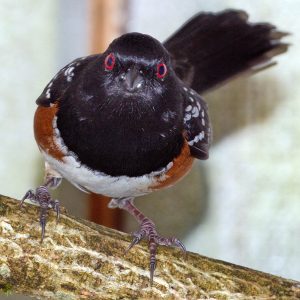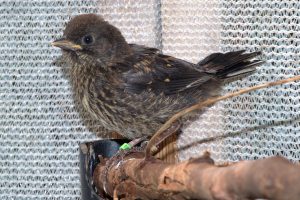Support Us
Since 1979 more than 140,000 animals have been treated by Wildlife Rescue.
Thanks to the support of individuals like you, Wildlife Rescue can provide a lifeline for animals in distress.

A familiar sight in British Columbia, male Spotted Towhees have reddish-orange flanks, black wings, and grey underwings, though the females have grey wings instead of black. These clever sparrows tend to dart from place to place by hopping rather than flying since they mainly forage for insects (such as beetles, ladybugs, crickets, grasshoppers, moths, and spiders), berries, seeds, and acorns (such as raspberries, blackberries, chickweed, oats, corn, and cherries).
Since Spotted Towhees mainly forage on the ground, it makes sense that they would create nests there too. Similar to other birds such as the Killdeer and California Quail, female Spotted Towhees create nests in exposed areas such as woodland edges, gardens, the base of a shrub, a clump of grass, or a log. They gather dry leaves, bark, and stems and then line the nest with grass and pine needles, often in a depression with soil at the surface of the rim which allows for camouflage of the nests and reduced predation. Spotted Towhees will also make elevated nests, but these are not as common as ground nests.
Lone Survivor Fighting for his life

Recently, a nest containing three Spotted Towhee babies was accidentally hit by a weedwhacker. Wildlife Rescue hospital was unable to save two of the babies because the injuries sustained by the babies were unfortunately too severe for survival. These types of injuries sustained from lawn equipment can vary greatly resulting in non-recoverable injuries such as missing limbs to treatable lacerations and head trauma.
Luckily, the lone survivor has a fighting chance to develop his feathers and learn essential skills for the wild before it safely returns to the wild. He is currently on a 90-minute feed and perching low, he will need to be old enough to fly and self-feed before he is released.
Spotted Towhees tend to nest on the ground, they are especially at risk of human intrusion and wildfires. The nests of these sparrows are often cleverly hidden from our sight – but issues arise when humans mow lawns and use pesticides. Not only can mowing our lawns harm these birds directly, but the loud noise may scare off the mother bird – leaving the nest vulnerable to predators. As well, pesticides can harm the food sources of these beautiful birds, making survival much harder. The fledglings are an easy target for domestic cats, dogs, and the unwitting person who picks them up as their ground nest allows for the young fledgling birds to venture from the nest before they are ready compared to elevated nests that keep the animal slightly more secure.
Tips to Help Ground-Nesters!
So, what can we do to help Spotted Towhees stay safe? There are a few simple things we can do to support them.
If you see a bird that has exposed bone or blood, bugs or insects covering it, no feathers, or a bird that is sleeping, human intervention is required. Please contact our Support Centre for assistance. Want to learn more about ground-nesting babies? Visit this article!
Help Support the Spotted Towhee Baby!